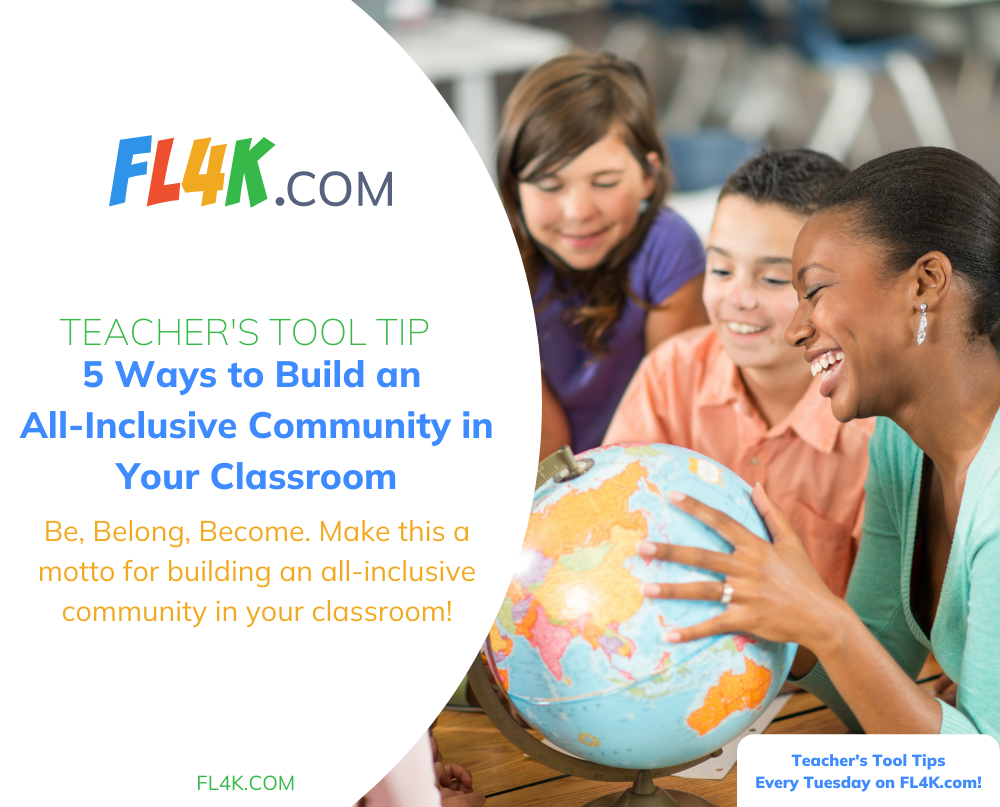Be, Belong, Become. Make this a motto for building an all-inclusive community in your classroom!
The World Language classroom is a place where students should BE accepted for who they are, BELONG to a supportive community, and BECOME the best language learner possible!
Unfortunately, the World Language classroom is often a place where intimidation can be very high! Some students naturally have better pronunciation, some have an easier time understanding and applying complicated grammar matrices, and some are extroverted with no fear of making mistakes or speaking in front of others.
The World Language classroom can be scary for the introverted or intimidated! You need to consider giving every student the best chance possible to succeed, and that takes learning a little about building community and practicing it every day in the classroom.
The following suggestions are not scientifically proven; they are simply things I learned on the job!
Give students the opportunity to get to know each other every day in your classroom!
Use small group and partner activities to reduce the intimidation factor. Mix them up randomly, too. Don’t allow them to always be with their friends. This leaves the shy students out and makes for a really miserable language learning experience for them.
Encourage support for every student by not calling out their mistakes in front of everyone.
I was once one of those who had to publicly correct every verb form or improper use of ser vs. estar. What a ridiculous, uninviting way to teach!
Let those mistakes go as long as there is communication happening. Once students have heard the correct language chunks enough, they will just begin to use them correctly.
In my opinion, we are so wrong to call out every grammar mistake every day for every child. It is discouraging and makes them terrified to ever speak the language! How antithetical is this to what we want to do in our classrooms?
Give students positive feedback!
Make it up! If they draw beautifully, comment on that! Find something good about every child and praise it!
Let your students know that you appreciate them in all their wonder, even if their wonder does not include being talented in learning a second language in your classroom. Connect with your students and let them know that you don’t judge their whole being on whether they are successful in your classroom!
This will go a long way toward opening their spirit to the possibility of having a positive language learning experience.
Measure students against themselves!
If a student can only get two words out the first time they speak in the class, praise that, and encourage them to get three or four out the next time! Let them know that they are making progress and that you have noticed it!
I have taught kids who stutter, have dyslexia, dysgraphia, ADHD, suffer from severe anxiety and depression, are painfully shy, struggle with family issues, just don’t get it, etc.
It was always incumbent on ME to make a comfortable learning situation for them! And guess what? It was always so rewarding to watch those challenged kids shine! And they can and will if you build the right community for them!
Make your classroom about the learning COMMUNITY and not about you and your frustrations with them!
Tune into your kids and hone your community-building skills.
Study Bruce Tuckman’s group development skills of forming, storming, norming, and performing.
Starting with these methods will help build an all-inclusive community in your classroom. In the next few weeks, I will share specific activities for the World Language classroom for each of these stages of group development based on a workshop that my friend and colleague, Elena Giudice, has brilliantly created.
Elena and I are now part of a teacher team that is helping to write curriculum for an amazing language program for kids! Check out FL4K.com to see the latest design for an innovative and interactive way of engaging kids in learning Spanish (for now and many more languages to come)!
Sign up here for our free trial and see what you think! And if you’ve missed any of my past tips, you can read them here!
